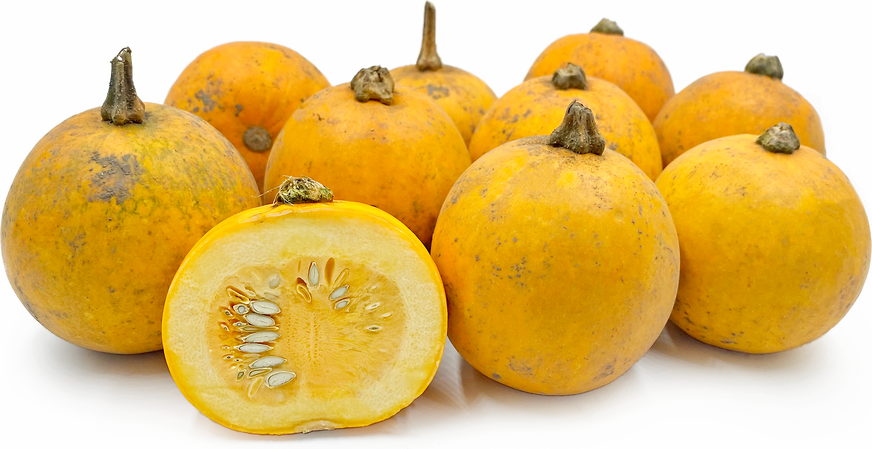


Lady Nail Pumpkin Squash
Estimated Inventory, lb : 0
Description/Taste
Lady Nail pumpkins are generally very small, easily fitting into the palm of a hand, and have a globular, oblong, to slightly flattened shape. The rind is smooth, firm, and ranges in color from a vibrant golden-orange to pale yellow. Underneath the surface, the flesh is dense, crisp, and light yellow, encasing a central cavity filled with stringy fibers and many flat, oblong, and tapered cream-colored seeds. Lady Nail pumpkins, when cooked, are juicy and tender with a sweet flavor due to its high sugar content. The seeds are also edible when raw and pressed into oil, or they can be fried, giving the seeds a crunchy consistency with a nutty, rich flavor.
Seasons/Availability
Lady Nail pumpkins are available in the fall through winter.
Current Facts
Lady Nail pumpkins, botanically classified as Cucurbita pepo, are a winter squash variety that belongs to the Cucurbitaceae family. Also known as Bulgarian squash or Bulgarian Lady Nail pumpkins, Lady Nail pumpkins are primarily utilized for their seeds and are named after the seed’s similarity in shape to a woman’s fingernail. In Europe and Asia, Lady Nail pumpkins are favored for their small size, high seed content, and juicy, sweet flesh, and are utilized in both sweet and savory dishes.
Nutritional Value
Lady Nail pumpkins are an excellent source of fiber and vitamin D, which can help promote bone growth, and contains some copper, carotene, vitamins A, C, and K, phosphorus, and iron. The seeds also provide zinc, calcium, copper, vitamin E, potassium, and some amino acids.
Applications
Lady Nail pumpkins are best suited for cooked applications such as baking, boiling, and roasting. The flesh can be incorporated into chilis, soups, and stews, stirred into casseroles, or roasted for a sweet, caramelized flavor and tender consistency. The flesh can also be mixed into fillings for desserts and pies, or pureed and blended into cheesecakes, muffins, and bread. In Central Asia, Lady Nail pumpkins are sometimes used in manti, which are dumplings traditionally filled with meat or pumpkin and are coated in a butter or yogurt sauce. They are also used as a serving vessel with the tops removed and the central fibers discarded, stuffed with minced meats, and then cooked and served whole. Lady Nail pumpkins pair well with pomegranate seeds, dried fruits, Brussel sprouts, corn, meats such as poultry, beef, and lamb, beans, rice, and olives. The small squash will keep 8-12 weeks when stored in a cool, dry, and dark place.
Ethnic/Cultural Info
In Central Asia, Lady Nail pumpkins are most popularly used for their flattened, oblong seeds. The seeds can be washed, dried, and pressed into a nutritious oil, comparable to olive oil, and is used for cooking, dressing salads, flavoring cooked vegetables, and for dipping bread. The oil is also used by many traditional herbalists for its health properties and has a light, nutty flavor. The oil is prescribed topically to soften the skin, scalp, and hair, and is ingested to help alleviate problems associated with the urinary tract. In addition to medicinal applications, Lady Nail pumpkin seeds are fried or roasted and consumed as a crunchy, chewy snack.
Geography/History
The origin of Lady Nail pumpkins is mostly unknown, but it has been said that the variety first gained notoriety at a local market in Almaty, Kazakhstan. A Russian vendor was selling the pumpkin, not knowing the specific variety, and the market consumers favored the pumpkins for their small size. Through investigation, discussion, and research, the name Lady Nail was discovered and became known across the country. Today Lady Nail pumpkins are available through local markets in Central Asia, Eastern Europe, and Russia. The seeds are also available on a local level and are sold through online catalogs internationally in North America, Europe, and Asia.








